Stan C. Smith's Blog, page 35
August 15, 2017
Profusion is almost here!
 Profusion is 115,000 words of excitement, narrow escapes, and awesome creatures. And it is the longest novel I have written yet, but it will be the same price as Infusion ($3.99).
However
, if you snatch it up on its release day (September 1), you can get it for only $0.99. Yep, for ONE DAY ONLY, it will be only 99 cents.
Profusion is 115,000 words of excitement, narrow escapes, and awesome creatures. And it is the longest novel I have written yet, but it will be the same price as Infusion ($3.99).
However
, if you snatch it up on its release day (September 1), you can get it for only $0.99. Yep, for ONE DAY ONLY, it will be only 99 cents.Here's the teaser:
*********************************************************
How can you save humanity if your only hope is to call upon an entity that could destroy us all?
As nations argue over who should possess the alien entity called the Lamotelokhai, 15-year-old Bobby Truex knows the answer—no one should. After all, he’s the one who told it to go into hiding. He knows, better than anyone, that misusing it leads to death and destruction. After months trying to overcome his guilt, Bobby’s life is suddenly shattered, forcing him to risk everything and once again ask for help from the most dangerous object imaginable.
Meanwhile, Quentin and Lindsey Darnell are tormented by the memory of leaving their son Addison to die in the Papuan rainforest. After learning he is still alive, they set out to find him but are shocked by what they discover. Addison is now part of something truly amazing, something that may result in the next stage of human evolution.
Now, Bobby must not only survive—he must make his way to the other side of the world to find Quentin and Lindsey. The fate of the planet depends on it.
*********************************************************
Remember--September 1st.
Published on August 15, 2017 05:10
July 27, 2017
Awesome Animal - Flying Fox
Yes, of course I have chosen an animal that makes an appearance in Profusion. But the flying fox in Profusion is definitely not one you would ever want to run into!
Flying foxes are actually bats. They are in the group of bats called fruit bats (mostly in the genus, Pteropus). Take a look at the face of just about any flying fox and you'll understand how they got their name. They have very fox-like faces. Below is a grey-headed flying fox.
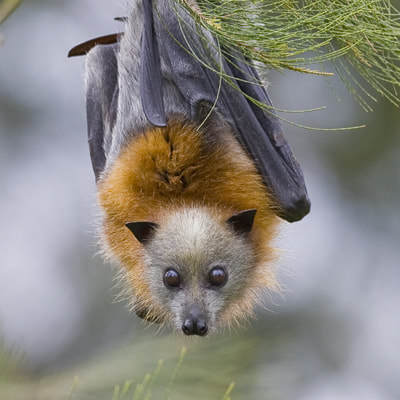 There are about 60 species of flying foxes, and they are widely spread throughout the subtropics of Asia, Australia, East Africa, and many islands in the Pacific and Indian Oceans. One thing that distinguishes flying foxes from other bats is that they eat fruit, pollen, nectar, or flowers. This means they have to live in areas that have flowers and fruit to eat year-round (tropical). Also, these bats do not have echolocation (sonar) to help them catch insects. Instead, they have very well-develop eyesight and smell.
There are about 60 species of flying foxes, and they are widely spread throughout the subtropics of Asia, Australia, East Africa, and many islands in the Pacific and Indian Oceans. One thing that distinguishes flying foxes from other bats is that they eat fruit, pollen, nectar, or flowers. This means they have to live in areas that have flowers and fruit to eat year-round (tropical). Also, these bats do not have echolocation (sonar) to help them catch insects. Instead, they have very well-develop eyesight and smell.
Check out this spectacular BBC video.
Amazing facts about Flying Foxes:
These are the largest bats in the world. The large flying fox (yes, that's its name... creative, huh?) has a wingspan of five feet (1.5 meter)! See image below.
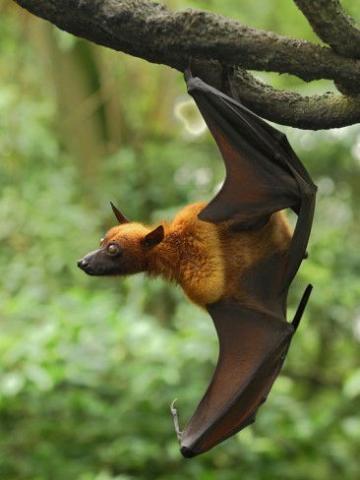 Some flying fox species are so rare they are found only on one small island. For example, the Mauritius flying fox (See photo below) lives only on the small island of Mauritius in the Indian Ocean. It is very important there because it pollinates flowers and disperses seeds of many plants that also live only on that island.
Some flying fox species are so rare they are found only on one small island. For example, the Mauritius flying fox (See photo below) lives only on the small island of Mauritius in the Indian Ocean. It is very important there because it pollinates flowers and disperses seeds of many plants that also live only on that island.
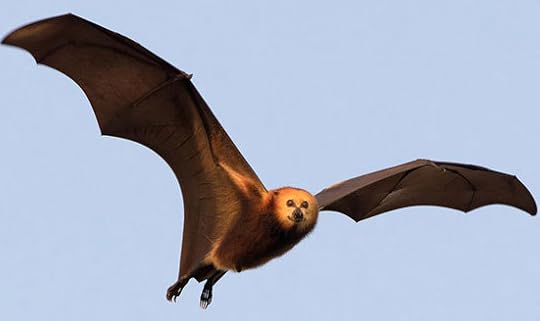 One reason why some flying foxes are rare is that they are simply not very prolific. In fact, the large flying fox usually has only one pup (I love that they're called pups), and that's after a gestation period of 180 days! And then it takes 3-4 months for the pup to be weaned, and it won't be sexually mature for about two years.
One reason why some flying foxes are rare is that they are simply not very prolific. In fact, the large flying fox usually has only one pup (I love that they're called pups), and that's after a gestation period of 180 days! And then it takes 3-4 months for the pup to be weaned, and it won't be sexually mature for about two years.
Flying foxes mate while they are hanging upside down. Um, this one doesn't need too much explanation, does it? Oh, I guess I could add that the male often has a penis that is one-fourth the length of his entire body. Are you starting to see the logistical problems involved here?
Flying foxes hang out (literally) in trees in massive groups called camps. Sometimes these camps can have several hundred thousand bats. But this isn't nearly as many as they used to have before their numbers were depleted. In the 1930s, there were camps that were four miles wide and had 30 million flying foxes!
So, the flying fox deserves a place in the S.A.H.O.F. (Supernacular Animal Hall of Fame).
FUN FACT: Supernacular comes from the noun, supernaculum, which means a drink to be consumed to the last drop. Although the word is usually used to describe a drink, I personally believe it should be expanded to describe anything that is awesome.
Flying foxes are actually bats. They are in the group of bats called fruit bats (mostly in the genus, Pteropus). Take a look at the face of just about any flying fox and you'll understand how they got their name. They have very fox-like faces. Below is a grey-headed flying fox.
 There are about 60 species of flying foxes, and they are widely spread throughout the subtropics of Asia, Australia, East Africa, and many islands in the Pacific and Indian Oceans. One thing that distinguishes flying foxes from other bats is that they eat fruit, pollen, nectar, or flowers. This means they have to live in areas that have flowers and fruit to eat year-round (tropical). Also, these bats do not have echolocation (sonar) to help them catch insects. Instead, they have very well-develop eyesight and smell.
There are about 60 species of flying foxes, and they are widely spread throughout the subtropics of Asia, Australia, East Africa, and many islands in the Pacific and Indian Oceans. One thing that distinguishes flying foxes from other bats is that they eat fruit, pollen, nectar, or flowers. This means they have to live in areas that have flowers and fruit to eat year-round (tropical). Also, these bats do not have echolocation (sonar) to help them catch insects. Instead, they have very well-develop eyesight and smell.Check out this spectacular BBC video.
Amazing facts about Flying Foxes:
These are the largest bats in the world. The large flying fox (yes, that's its name... creative, huh?) has a wingspan of five feet (1.5 meter)! See image below.
 Some flying fox species are so rare they are found only on one small island. For example, the Mauritius flying fox (See photo below) lives only on the small island of Mauritius in the Indian Ocean. It is very important there because it pollinates flowers and disperses seeds of many plants that also live only on that island.
Some flying fox species are so rare they are found only on one small island. For example, the Mauritius flying fox (See photo below) lives only on the small island of Mauritius in the Indian Ocean. It is very important there because it pollinates flowers and disperses seeds of many plants that also live only on that island. One reason why some flying foxes are rare is that they are simply not very prolific. In fact, the large flying fox usually has only one pup (I love that they're called pups), and that's after a gestation period of 180 days! And then it takes 3-4 months for the pup to be weaned, and it won't be sexually mature for about two years.
One reason why some flying foxes are rare is that they are simply not very prolific. In fact, the large flying fox usually has only one pup (I love that they're called pups), and that's after a gestation period of 180 days! And then it takes 3-4 months for the pup to be weaned, and it won't be sexually mature for about two years.Flying foxes mate while they are hanging upside down. Um, this one doesn't need too much explanation, does it? Oh, I guess I could add that the male often has a penis that is one-fourth the length of his entire body. Are you starting to see the logistical problems involved here?
Flying foxes hang out (literally) in trees in massive groups called camps. Sometimes these camps can have several hundred thousand bats. But this isn't nearly as many as they used to have before their numbers were depleted. In the 1930s, there were camps that were four miles wide and had 30 million flying foxes!
So, the flying fox deserves a place in the S.A.H.O.F. (Supernacular Animal Hall of Fame).
FUN FACT: Supernacular comes from the noun, supernaculum, which means a drink to be consumed to the last drop. Although the word is usually used to describe a drink, I personally believe it should be expanded to describe anything that is awesome.
Published on July 27, 2017 18:44
PROFUSION Cover Reveal!
I am so excited about this cover! Profusion will be released soon, and my cover designer, Donna Harriman Murillo, has done it again. Feast your eyes on the cover, in all its colorful, action-packed glory:  By the way, that's Bobby on the cover. The question is, what the heck has happened to him? And what's going on in the background? Things are getting serious.
By the way, that's Bobby on the cover. The question is, what the heck has happened to him? And what's going on in the background? Things are getting serious.
PROFUSION. The stakes are higher, the action is more intense, and the creatures are awesome! Coming in September.
 By the way, that's Bobby on the cover. The question is, what the heck has happened to him? And what's going on in the background? Things are getting serious.
By the way, that's Bobby on the cover. The question is, what the heck has happened to him? And what's going on in the background? Things are getting serious.PROFUSION. The stakes are higher, the action is more intense, and the creatures are awesome! Coming in September.
Published on July 27, 2017 18:40
July 5, 2017
The best order in which to read my books
People often ask what is the best sequence in which to read my books. This is a good question, because at this point all my published books take place in the
Diffusion
universe (although I have an upcoming series that will be unrelated). The order in which you read them can certainly impact the way you perceive the overall story. There are two reasonable sequences:
If you want to read them in chronological order of the events that take place, you should read them as follows (from left to right):
 And then, logically, you would read
Profusion
when it comes out later this summer.
And then, logically, you would read
Profusion
when it comes out later this summer.
Or, you could read them in the order I had originally intended (think of this as the Director's Cut):
 And then you would read the upcoming
Profusion
after Blue Arrow. I personally like this sequence because it gradually reveals information in a way that appeals to me. For example, even though
Savage
takes place in 1868, long before
Diffusion
, it is a part of the story you will appreciate more if you have read
Diffusion
and
Infusion
. The same could be said for
Blue Arrow
.
And then you would read the upcoming
Profusion
after Blue Arrow. I personally like this sequence because it gradually reveals information in a way that appeals to me. For example, even though
Savage
takes place in 1868, long before
Diffusion
, it is a part of the story you will appreciate more if you have read
Diffusion
and
Infusion
. The same could be said for
Blue Arrow
.
But regardless of what order, the important thing is to read them! You can get them all here:
https://amazon.com/author/stancsmith
If you want to read them in chronological order of the events that take place, you should read them as follows (from left to right):
 And then, logically, you would read
Profusion
when it comes out later this summer.
And then, logically, you would read
Profusion
when it comes out later this summer.Or, you could read them in the order I had originally intended (think of this as the Director's Cut):
 And then you would read the upcoming
Profusion
after Blue Arrow. I personally like this sequence because it gradually reveals information in a way that appeals to me. For example, even though
Savage
takes place in 1868, long before
Diffusion
, it is a part of the story you will appreciate more if you have read
Diffusion
and
Infusion
. The same could be said for
Blue Arrow
.
And then you would read the upcoming
Profusion
after Blue Arrow. I personally like this sequence because it gradually reveals information in a way that appeals to me. For example, even though
Savage
takes place in 1868, long before
Diffusion
, it is a part of the story you will appreciate more if you have read
Diffusion
and
Infusion
. The same could be said for
Blue Arrow
.But regardless of what order, the important thing is to read them! You can get them all here:
https://amazon.com/author/stancsmith
Published on July 05, 2017 05:57
Awesome Animal - Blue-tailed Monitor
In my upcoming novel, Profusion, Samuel collects a two-foot-long lizard which he plans to use for an experiment. It turns out this lizard is a blue-tailed monitor (Varanus doreanus).
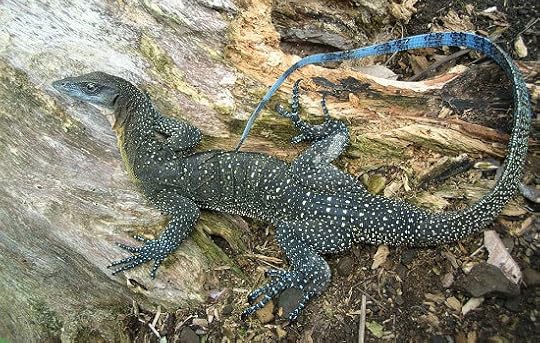 By the way, Samuel's experiment with the monitor lizard goes very, very badly. But you'll have to read Profusion when it comes out (by the end of the summer) to find out just how badly!
By the way, Samuel's experiment with the monitor lizard goes very, very badly. But you'll have to read Profusion when it comes out (by the end of the summer) to find out just how badly!
There are about 80 species of monitor lizards, living mainly in Africa, Asia, Australia, and New Guinea. Perhaps the most famous monitor is the Komodo monitor (often called the Komodo Dragon), which is the largest species of lizard living today (up to 10 feet long and 150 pounds!). But I chose the blue-tailed monitor for today's awesome animal, because I am fascinated by the smaller monitor lizards, particularly those with unusual colors.
Amazing facts about blue-tailed monitors:
The blue-tailed monitor is somewhat of a celebrity in Papua New Guinea and has been featured on one of their postage stamps:
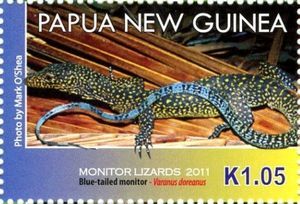 This lizard is at home in the trees, on the ground, and in the water. They are excellent swimmers and climbers, but as they grow larger and heavier, they tend to hang out on the ground more than in the trees. Here's a short video that shows how they use their tail to swim.
This lizard is at home in the trees, on the ground, and in the water. They are excellent swimmers and climbers, but as they grow larger and heavier, they tend to hang out on the ground more than in the trees. Here's a short video that shows how they use their tail to swim.
Blue-tailed monitors are exported as pets to the U.S. and Europe. But since they often grow to four or five feet, require large, spacious cages, and live 10 to 15 years, they are only suitable for the most dedicated pet enthusiasts.
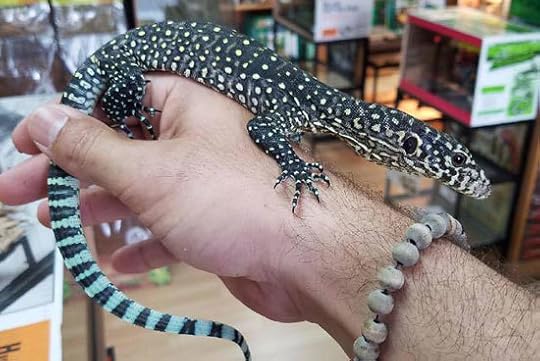 Interesting story about how monitor lizards got their name, as told by an
Interesting story about how monitor lizards got their name, as told by an
The blue-tailed monitor is not the only brightly-colored monitor lizard. Below is the blue-spotted tree monitor, which lives only on the small island of Batanta, off the west coast of New Guinea.
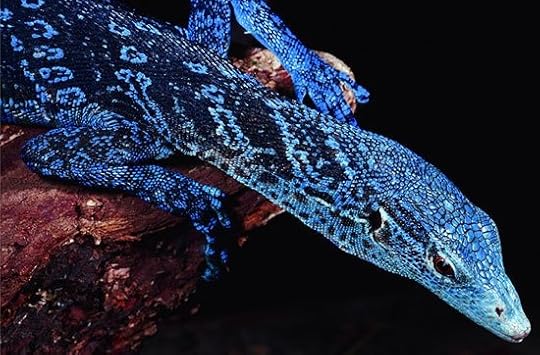 What I'd like to know, is why are these lizards blue in the first place? After digging for answers a bit, I'm not sure there is a clear-cut answer to this. It seems unlikely these bright colors are used by the males to attract mates (as with many birds), because both males and females have the same colors. If anyone has a good hypothesis, email me and let me know.
What I'd like to know, is why are these lizards blue in the first place? After digging for answers a bit, I'm not sure there is a clear-cut answer to this. It seems unlikely these bright colors are used by the males to attract mates (as with many birds), because both males and females have the same colors. If anyone has a good hypothesis, email me and let me know.
So, the blue-tailed monitor deserves a place in the G.A.H.O.F. (Gallows Animal Hall of Fame).
FUN FACT: Gallows originally meant "fit for the gallows," meaning, deserving to be hanged. But by 1789, it had become a slang adjective meaning awesome, in the same way that wicked and bad have come to mean their opposite. How gallows is that?
Photo Credits:
Monitor photo #1 - Reptile Fact
Papua Stamp - Mark O'Shea
Pet Monitor - Snakes at Sunset
Blue-spotted Tree Monitor - Australian Geographic
 By the way, Samuel's experiment with the monitor lizard goes very, very badly. But you'll have to read Profusion when it comes out (by the end of the summer) to find out just how badly!
By the way, Samuel's experiment with the monitor lizard goes very, very badly. But you'll have to read Profusion when it comes out (by the end of the summer) to find out just how badly!There are about 80 species of monitor lizards, living mainly in Africa, Asia, Australia, and New Guinea. Perhaps the most famous monitor is the Komodo monitor (often called the Komodo Dragon), which is the largest species of lizard living today (up to 10 feet long and 150 pounds!). But I chose the blue-tailed monitor for today's awesome animal, because I am fascinated by the smaller monitor lizards, particularly those with unusual colors.
Amazing facts about blue-tailed monitors:
The blue-tailed monitor is somewhat of a celebrity in Papua New Guinea and has been featured on one of their postage stamps:
 This lizard is at home in the trees, on the ground, and in the water. They are excellent swimmers and climbers, but as they grow larger and heavier, they tend to hang out on the ground more than in the trees. Here's a short video that shows how they use their tail to swim.
This lizard is at home in the trees, on the ground, and in the water. They are excellent swimmers and climbers, but as they grow larger and heavier, they tend to hang out on the ground more than in the trees. Here's a short video that shows how they use their tail to swim.Blue-tailed monitors are exported as pets to the U.S. and Europe. But since they often grow to four or five feet, require large, spacious cages, and live 10 to 15 years, they are only suitable for the most dedicated pet enthusiasts.
 Interesting story about how monitor lizards got their name, as told by an
Interesting story about how monitor lizards got their name, as told by an The blue-tailed monitor is not the only brightly-colored monitor lizard. Below is the blue-spotted tree monitor, which lives only on the small island of Batanta, off the west coast of New Guinea.
 What I'd like to know, is why are these lizards blue in the first place? After digging for answers a bit, I'm not sure there is a clear-cut answer to this. It seems unlikely these bright colors are used by the males to attract mates (as with many birds), because both males and females have the same colors. If anyone has a good hypothesis, email me and let me know.
What I'd like to know, is why are these lizards blue in the first place? After digging for answers a bit, I'm not sure there is a clear-cut answer to this. It seems unlikely these bright colors are used by the males to attract mates (as with many birds), because both males and females have the same colors. If anyone has a good hypothesis, email me and let me know.So, the blue-tailed monitor deserves a place in the G.A.H.O.F. (Gallows Animal Hall of Fame).
FUN FACT: Gallows originally meant "fit for the gallows," meaning, deserving to be hanged. But by 1789, it had become a slang adjective meaning awesome, in the same way that wicked and bad have come to mean their opposite. How gallows is that?
Photo Credits:
Monitor photo #1 - Reptile Fact
Papua Stamp - Mark O'Shea
Pet Monitor - Snakes at Sunset
Blue-spotted Tree Monitor - Australian Geographic
Published on July 05, 2017 05:44
June 8, 2017
Awesome Animal - The Bowerbird
In my novel, Diffusion, Quentin finds a stone talisman that turns out to be very important. But the place where he finds it is interesting as well. The talisman is basically a small stone (although carved to resemble a creature). It is found by a male BOWERBIRD and incorporated into the bird's elaborate "bower," where Quentin eventually finds it.
Bowerbird bowers are part of a mating ritual that is almost beyond belief. In order to impress females, the male bowerbird creates a spectacular structure with sticks, clears away the ground in front of it, and then painstakingly collects "treasures" and puts them into neat piles, sorted by size, texture, and color.
 There are about 20 species of bowerbirds, ranging from bright orange in color to dull brown. Most of them live in New Guinea and/or northeastern Australia.
There are about 20 species of bowerbirds, ranging from bright orange in color to dull brown. Most of them live in New Guinea and/or northeastern Australia.
I've always been fascinated by the fact that, in most animals, it is the males that have developed incredible behaviors and physical characteristics to attract mates. It is the male's job to prove he is worthy (healthy and strong... in other words, likely to produce healthy, strong offspring). It is the female's job to be aloof and picky. Much research has been done on this, and it has to do with the amount of energy females put into producing offspring compared to males (as in A LOT MORE!). But that's a topic for a future email.
Check out this video from the BBC of the courtship of the flame bowerbird (prepare to be amazed):
https://www.youtube.com/watch?v=1XkPeN3AWIE
Amazing Facts about Bowerbirds:
Male regent bowerbirds actually paint the sticks that make up their bower. They do this with their blue or green saliva, often painting it on using a leaf as a paintbrush. A rare example of tool use in birds!
The Vogelkop bowerbird creates bowers that are a meter high and 1.5 meters wide (see the photo below). They decorate their "lawn" with piles of brightly-colored flowers and other objects. Whenever these start rotting or loosing their color, the birds replace them with fresh ones.
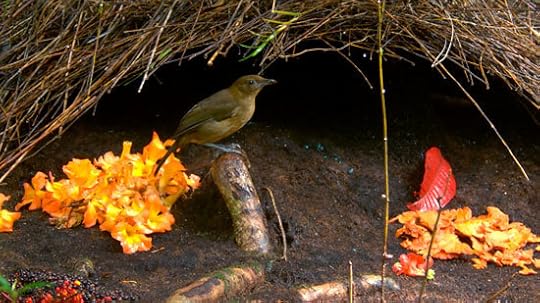 When bowerbirds live near civilization, they often collect human-made objects because they are bright-colored. The Satin bowerbird below has collected pieces of blue plastic. Notice the drab female watching him perform from inside the bower.
When bowerbirds live near civilization, they often collect human-made objects because they are bright-colored. The Satin bowerbird below has collected pieces of blue plastic. Notice the drab female watching him perform from inside the bower. 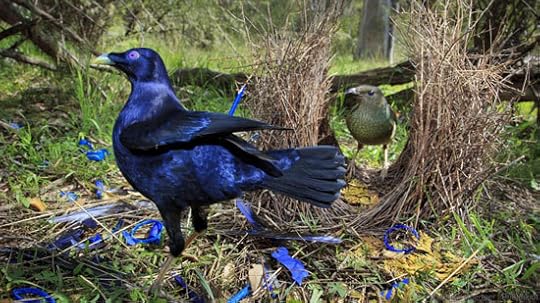 Male bowerbirds work so hard on their bowers, expending valuable energy doing so, that this has resulted in the habit of raiding each other's bowers. When a male leaves his bower unguarded, another male might swoop in and steal some of his hard-earned treasures. Sometimes they even tear down the bower structure itself. That is terribly rude, but I guess all is fair in love and war.
Male bowerbirds work so hard on their bowers, expending valuable energy doing so, that this has resulted in the habit of raiding each other's bowers. When a male leaves his bower unguarded, another male might swoop in and steal some of his hard-earned treasures. Sometimes they even tear down the bower structure itself. That is terribly rude, but I guess all is fair in love and war.
Males build their bowers so the sun will shine on their bright treasures and on themselves. After all, the best presentation will win the female. So in forests with an open canopy, they build them with a north-south orientation. In a closed canopy forest, they build them near a gap in the canopy.
So the bowerbird deserves a place in the P.A.H.O.F. (Prestantious Animal Hall of Fame).
FUN FACT: Prestantious is from a latin word meaning excellence. It is a very rare word, as it has appeared only once in the Oxford English Dictionary, stating that it was used once in a book written in 1638, The Blood of the Grape. Basically, it means awesome.
Photo Credits:
Bowerbird bower - Ingo Arndt/National Geographic
Vogelkop Bowerbird - BBC (http://www.bbc.co.uk/programmes/b04dwdm3)
Satin Bowerbirds - Gerhard Koertner / Photoshot - BBC
Bowerbird bowers are part of a mating ritual that is almost beyond belief. In order to impress females, the male bowerbird creates a spectacular structure with sticks, clears away the ground in front of it, and then painstakingly collects "treasures" and puts them into neat piles, sorted by size, texture, and color.
 There are about 20 species of bowerbirds, ranging from bright orange in color to dull brown. Most of them live in New Guinea and/or northeastern Australia.
There are about 20 species of bowerbirds, ranging from bright orange in color to dull brown. Most of them live in New Guinea and/or northeastern Australia.I've always been fascinated by the fact that, in most animals, it is the males that have developed incredible behaviors and physical characteristics to attract mates. It is the male's job to prove he is worthy (healthy and strong... in other words, likely to produce healthy, strong offspring). It is the female's job to be aloof and picky. Much research has been done on this, and it has to do with the amount of energy females put into producing offspring compared to males (as in A LOT MORE!). But that's a topic for a future email.
Check out this video from the BBC of the courtship of the flame bowerbird (prepare to be amazed):
https://www.youtube.com/watch?v=1XkPeN3AWIE
Amazing Facts about Bowerbirds:
Male regent bowerbirds actually paint the sticks that make up their bower. They do this with their blue or green saliva, often painting it on using a leaf as a paintbrush. A rare example of tool use in birds!
The Vogelkop bowerbird creates bowers that are a meter high and 1.5 meters wide (see the photo below). They decorate their "lawn" with piles of brightly-colored flowers and other objects. Whenever these start rotting or loosing their color, the birds replace them with fresh ones.
 When bowerbirds live near civilization, they often collect human-made objects because they are bright-colored. The Satin bowerbird below has collected pieces of blue plastic. Notice the drab female watching him perform from inside the bower.
When bowerbirds live near civilization, they often collect human-made objects because they are bright-colored. The Satin bowerbird below has collected pieces of blue plastic. Notice the drab female watching him perform from inside the bower.  Male bowerbirds work so hard on their bowers, expending valuable energy doing so, that this has resulted in the habit of raiding each other's bowers. When a male leaves his bower unguarded, another male might swoop in and steal some of his hard-earned treasures. Sometimes they even tear down the bower structure itself. That is terribly rude, but I guess all is fair in love and war.
Male bowerbirds work so hard on their bowers, expending valuable energy doing so, that this has resulted in the habit of raiding each other's bowers. When a male leaves his bower unguarded, another male might swoop in and steal some of his hard-earned treasures. Sometimes they even tear down the bower structure itself. That is terribly rude, but I guess all is fair in love and war.Males build their bowers so the sun will shine on their bright treasures and on themselves. After all, the best presentation will win the female. So in forests with an open canopy, they build them with a north-south orientation. In a closed canopy forest, they build them near a gap in the canopy.
So the bowerbird deserves a place in the P.A.H.O.F. (Prestantious Animal Hall of Fame).
FUN FACT: Prestantious is from a latin word meaning excellence. It is a very rare word, as it has appeared only once in the Oxford English Dictionary, stating that it was used once in a book written in 1638, The Blood of the Grape. Basically, it means awesome.
Photo Credits:
Bowerbird bower - Ingo Arndt/National Geographic
Vogelkop Bowerbird - BBC (http://www.bbc.co.uk/programmes/b04dwdm3)
Satin Bowerbirds - Gerhard Koertner / Photoshot - BBC
Published on June 08, 2017 15:15
June 2, 2017
Awesome Animal - Death Adder
In my upcoming novel, Profusion, one of the fascinating animals that makes an appearance is the Death Adder, a venomous snake that lives in eastern Australia and New Guinea (part of Profusion takes place in the rainforest of Papua, the Indonesian province that is the western half of New Guinea). The name "Death Adder" certainly implies that this creature is dangerous (which it is), but actually the name is derived from "Deaf Adder," the name given to the snake by early Australian settlers. They called it the deaf adder because, unlike many other snakes, these held their ground and did not slither away when approached by people. So people assumed they were deaf. It is important to note, though, that snakes in general do not actually "hear" the way we do. Instead, they sense vibration in the ground, and the death adder is no different from other snakes in that respect.
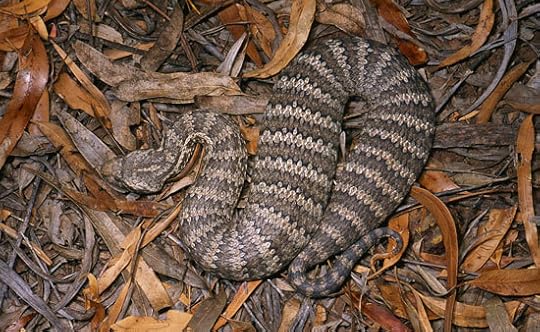 Scientists do not agree on how many species of death adders exist. Depending on the source (or how you define a species), there are 4 to 14 species.
Scientists do not agree on how many species of death adders exist. Depending on the source (or how you define a species), there are 4 to 14 species.
Amazing Facts about Death Adders:
Death Adders, like all snakes, are predators. But instead of going after their prey, they sit still, often hidden beneath the soil or leaves, and wait for prey to come to them. To help lure prey closer, they have a modified tip on their tail that they move around, making it look like a wriggling worm. This attracts birds, rodents, frogs, and lizards to take a closer look. Typically this is the last closer look they ever take at anything. There is a scene in Profusion in which a tree kangaroo (our good old friend, Mbaiso) encounters just such a thing. If you want to know what happens, you will have to read the book when it comes out this summer!
 Check out this cool video of "caudal luring" of a death adder:
Check out this cool video of "caudal luring" of a death adder:
https://www.youtube.com/watch?v=WXtN9PER5UE
Death adders can be deadly! They are among the most dangerous snakes, and they can inject up to 100 mg of a very undesirable neurotoxin (affects the central nervous system rather than just the tissue around the bite). And they strike amazingly fast. They can go from the strike position, hit their prey and inject venom, and back to the strike position in 0.15 seconds. They are the world record holders for strike speed!
In Australia, death adders often kill and eat giant marine toads. There is good news and bad news regarding this. Since marine toads are not native to Australia, and in fact are considered damaging to the ecosystem, this is the good news. The bad news is that marine toads have toxic glands on their skin. Once the marine toad is swallowed, the toxin from these glands kills the death adder. Talk about a lose-lose situation!
Death Adders look much like vipers (many venomous snakes are in the viper family, with short, fat bodies and triangular heads), but they aren't vipers at all. And they aren't adders either, in spite of their name. They are actually "Elapids" (more closely related to cobras and coral snakes).
Speaking of vipers, when Trish and I were hiking the Flint Hills of Kansas a few weeks ago, we came across a copperhead (photo below). Copperheads are "pit vipers," which means they have heat-sensing pits on their faces that help them detect warm-blooded prey. Notice how similar the death adder is to the copperhead. This is a result of "convergent evolution," which is when animals (or plants) that are not closely related evolve similar characteristics because those characteristics best suit their habits and environment.
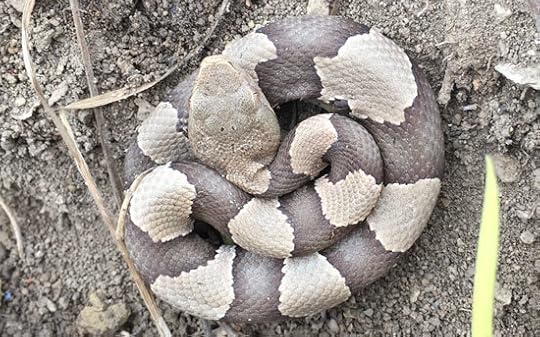 So the death adder deserves a place in the J.A.H.O.F. (Jelly Animal Hall of Fame).
So the death adder deserves a place in the J.A.H.O.F. (Jelly Animal Hall of Fame).
Fun Fact: Jelly is a term used as early as the mid 1500s. It was used to describe someone who was excellent (but particularly if they had a high opinion of themselves). It may have come from the word jolly, but no one knows for sure. Basically, it means awesome.
Photo Credits:
First death adder photo by Steve K Wilson.
Death Adder caudal lure: Queensland Museum
 Scientists do not agree on how many species of death adders exist. Depending on the source (or how you define a species), there are 4 to 14 species.
Scientists do not agree on how many species of death adders exist. Depending on the source (or how you define a species), there are 4 to 14 species.Amazing Facts about Death Adders:
Death Adders, like all snakes, are predators. But instead of going after their prey, they sit still, often hidden beneath the soil or leaves, and wait for prey to come to them. To help lure prey closer, they have a modified tip on their tail that they move around, making it look like a wriggling worm. This attracts birds, rodents, frogs, and lizards to take a closer look. Typically this is the last closer look they ever take at anything. There is a scene in Profusion in which a tree kangaroo (our good old friend, Mbaiso) encounters just such a thing. If you want to know what happens, you will have to read the book when it comes out this summer!
 Check out this cool video of "caudal luring" of a death adder:
Check out this cool video of "caudal luring" of a death adder:https://www.youtube.com/watch?v=WXtN9PER5UE
Death adders can be deadly! They are among the most dangerous snakes, and they can inject up to 100 mg of a very undesirable neurotoxin (affects the central nervous system rather than just the tissue around the bite). And they strike amazingly fast. They can go from the strike position, hit their prey and inject venom, and back to the strike position in 0.15 seconds. They are the world record holders for strike speed!
In Australia, death adders often kill and eat giant marine toads. There is good news and bad news regarding this. Since marine toads are not native to Australia, and in fact are considered damaging to the ecosystem, this is the good news. The bad news is that marine toads have toxic glands on their skin. Once the marine toad is swallowed, the toxin from these glands kills the death adder. Talk about a lose-lose situation!
Death Adders look much like vipers (many venomous snakes are in the viper family, with short, fat bodies and triangular heads), but they aren't vipers at all. And they aren't adders either, in spite of their name. They are actually "Elapids" (more closely related to cobras and coral snakes).
Speaking of vipers, when Trish and I were hiking the Flint Hills of Kansas a few weeks ago, we came across a copperhead (photo below). Copperheads are "pit vipers," which means they have heat-sensing pits on their faces that help them detect warm-blooded prey. Notice how similar the death adder is to the copperhead. This is a result of "convergent evolution," which is when animals (or plants) that are not closely related evolve similar characteristics because those characteristics best suit their habits and environment.
 So the death adder deserves a place in the J.A.H.O.F. (Jelly Animal Hall of Fame).
So the death adder deserves a place in the J.A.H.O.F. (Jelly Animal Hall of Fame).Fun Fact: Jelly is a term used as early as the mid 1500s. It was used to describe someone who was excellent (but particularly if they had a high opinion of themselves). It may have come from the word jolly, but no one knows for sure. Basically, it means awesome.
Photo Credits:
First death adder photo by Steve K Wilson.
Death Adder caudal lure: Queensland Museum
Published on June 02, 2017 05:33
May 14, 2017
Awesome Animal - Giant Ground Sloth
I bet everyone, at some point in their lives, wishes they had a time machine. I am no exception, and the reason why is that I would love to go back and see some of the awesome animals that are now extinct. Those of you who have read Diffusion, Infusion, or Savage know that the Lamotelokhai (the mysterious substance that has been hiding on our planet for millions of years) has vast knowledge of every living thing it has ever encountered. And it can recreate any creature from the past. As Samuel Inwood aptly states in my upcoming novel, Profusion, "The Lamotelokhai works in many media, but in my opinion it is a master of the medium of life. It sculpts and paints living organisms as if it were a god."
But when such power is wielded without regard to consequences, chaos can result, as you will soon see when Profusion comes out in a few months.
One of the many strange creatures encountered in Profusion is a Giant Ground Sloth. There were numerous species of ground sloths, and they became extinct about 10,000 years ago. Ground sloths lived throughout South America and most of North America. Not surprisingly, their extinction corresponds closely with the appearance of humans in North and South America, and it is thought that over-hunting by humans contributed to their demise.
Ground sloths lived throughout South America and most of North America. Not surprisingly, their extinction corresponds closely with the appearance of humans in North and South America, and it is thought that over-hunting by humans contributed to their demise.
Amazing Facts about extinct ground sloths:
The largest ground sloth (10 feet long and 2,200 lbs) was named after Thomas Jefferson. Before he became the third president of the US, he was very interested in fossils (a gentleman naturalist, like Samuel in my novel Savage). A friend sent him some bones found in a cave and Jefferson figured out that they belonged to a new species of ground sloth, which was then given the name, Megalonyx jeffersonii. The skeleton of this species in the photo below was found in a cave in my home state of Missouri.
 Ground sloths were herbivores (plant eaters), and their teeth were flat and peg-like. They also had long, curved claws on their front feet for grabbing limbs and stripping off the leaves (and maybe for protection from predators like the saber-toothed cats that lived at the same time).
Ground sloths were herbivores (plant eaters), and their teeth were flat and peg-like. They also had long, curved claws on their front feet for grabbing limbs and stripping off the leaves (and maybe for protection from predators like the saber-toothed cats that lived at the same time).
They had huge hind feet and a long, fat tail they used to stabilize themselves as they stood up (like a tripod) to reach higher branches.
One group of ground sloths became aquatic mammals! Yep, you read this correctly. About 8 million years ago, sloths of the genus Thalassocrus lived near water and started eating water plants. Within a few million years these critters had become fully aquatic and could swim like sea lions. Sadly, the aquatic sloths disappeared about 4 million years ago.
In 1995, Trish and I were lucky enough to get a behind-the-scenes tour of the basement storage areas of the Smithsonian Museum. Our guide opened a drawer, took out a large object, and explained that it was well-preserved giant sloth poop. He asked if I wanted to hold it. Are you kidding me? Of course did! (this photo was when I had no gray hair, no beard, and I was running marathons--please don't laugh).
 As I'm sure you know, there are several species of sloths living today (six, to be exact). They are much smaller and are called tree sloths. But they will be a topic of a future post.
As I'm sure you know, there are several species of sloths living today (six, to be exact). They are much smaller and are called tree sloths. But they will be a topic of a future post.
So the giant ground sloth deserves a place in the T.A.H.O.F. (Topgallant Animal Hall of Fame).
Fun Fact: Topgallant was originally a nautical term, a name for the head of the topmast. It eventually evolved into an adjective to describe anything lofty or grand. In other words, it means "awesome."
But when such power is wielded without regard to consequences, chaos can result, as you will soon see when Profusion comes out in a few months.
One of the many strange creatures encountered in Profusion is a Giant Ground Sloth. There were numerous species of ground sloths, and they became extinct about 10,000 years ago.
 Ground sloths lived throughout South America and most of North America. Not surprisingly, their extinction corresponds closely with the appearance of humans in North and South America, and it is thought that over-hunting by humans contributed to their demise.
Ground sloths lived throughout South America and most of North America. Not surprisingly, their extinction corresponds closely with the appearance of humans in North and South America, and it is thought that over-hunting by humans contributed to their demise.Amazing Facts about extinct ground sloths:
The largest ground sloth (10 feet long and 2,200 lbs) was named after Thomas Jefferson. Before he became the third president of the US, he was very interested in fossils (a gentleman naturalist, like Samuel in my novel Savage). A friend sent him some bones found in a cave and Jefferson figured out that they belonged to a new species of ground sloth, which was then given the name, Megalonyx jeffersonii. The skeleton of this species in the photo below was found in a cave in my home state of Missouri.
 Ground sloths were herbivores (plant eaters), and their teeth were flat and peg-like. They also had long, curved claws on their front feet for grabbing limbs and stripping off the leaves (and maybe for protection from predators like the saber-toothed cats that lived at the same time).
Ground sloths were herbivores (plant eaters), and their teeth were flat and peg-like. They also had long, curved claws on their front feet for grabbing limbs and stripping off the leaves (and maybe for protection from predators like the saber-toothed cats that lived at the same time).They had huge hind feet and a long, fat tail they used to stabilize themselves as they stood up (like a tripod) to reach higher branches.
One group of ground sloths became aquatic mammals! Yep, you read this correctly. About 8 million years ago, sloths of the genus Thalassocrus lived near water and started eating water plants. Within a few million years these critters had become fully aquatic and could swim like sea lions. Sadly, the aquatic sloths disappeared about 4 million years ago.
In 1995, Trish and I were lucky enough to get a behind-the-scenes tour of the basement storage areas of the Smithsonian Museum. Our guide opened a drawer, took out a large object, and explained that it was well-preserved giant sloth poop. He asked if I wanted to hold it. Are you kidding me? Of course did! (this photo was when I had no gray hair, no beard, and I was running marathons--please don't laugh).
 As I'm sure you know, there are several species of sloths living today (six, to be exact). They are much smaller and are called tree sloths. But they will be a topic of a future post.
As I'm sure you know, there are several species of sloths living today (six, to be exact). They are much smaller and are called tree sloths. But they will be a topic of a future post.So the giant ground sloth deserves a place in the T.A.H.O.F. (Topgallant Animal Hall of Fame).
Fun Fact: Topgallant was originally a nautical term, a name for the head of the topmast. It eventually evolved into an adjective to describe anything lofty or grand. In other words, it means "awesome."
Published on May 14, 2017 10:10
May 13, 2017
The Kansas Flint Hills - A natural treasure!
Trish and I just got back from a five-day visit to the amazing Flint Hills of eastern Kansas, in my opinion one of the most beautiful places on Earth. Trish and I got in some terrific hikes, and we even managed to find a nice variety of snakes.
 Yep, we like to look for snakes together... our idea of a romantic getaway. We take photos and then leave them to go about their business. The Milk Snake below is one of many we found. Beautiful, isn't it?
Yep, we like to look for snakes together... our idea of a romantic getaway. We take photos and then leave them to go about their business. The Milk Snake below is one of many we found. Beautiful, isn't it?
 The place we stayed is called the Flying W Ranch, in Chase County, Kansas (Chase County is the topic and setting for the book, PrairyErth, by William Least Heat-Moon). We also spent a few days at the Flying H Ranch about 20 miles from there. The Flying W Ranch has 7,000 acres of Flint Hills tall-grass prairie that looks very much the same as it has looked for thousands of years. It is an underappreciated natural environment. But don't give away the secret... we love how quiet it is there!
The place we stayed is called the Flying W Ranch, in Chase County, Kansas (Chase County is the topic and setting for the book, PrairyErth, by William Least Heat-Moon). We also spent a few days at the Flying H Ranch about 20 miles from there. The Flying W Ranch has 7,000 acres of Flint Hills tall-grass prairie that looks very much the same as it has looked for thousands of years. It is an underappreciated natural environment. But don't give away the secret... we love how quiet it is there!

 Yep, we like to look for snakes together... our idea of a romantic getaway. We take photos and then leave them to go about their business. The Milk Snake below is one of many we found. Beautiful, isn't it?
Yep, we like to look for snakes together... our idea of a romantic getaway. We take photos and then leave them to go about their business. The Milk Snake below is one of many we found. Beautiful, isn't it? The place we stayed is called the Flying W Ranch, in Chase County, Kansas (Chase County is the topic and setting for the book, PrairyErth, by William Least Heat-Moon). We also spent a few days at the Flying H Ranch about 20 miles from there. The Flying W Ranch has 7,000 acres of Flint Hills tall-grass prairie that looks very much the same as it has looked for thousands of years. It is an underappreciated natural environment. But don't give away the secret... we love how quiet it is there!
The place we stayed is called the Flying W Ranch, in Chase County, Kansas (Chase County is the topic and setting for the book, PrairyErth, by William Least Heat-Moon). We also spent a few days at the Flying H Ranch about 20 miles from there. The Flying W Ranch has 7,000 acres of Flint Hills tall-grass prairie that looks very much the same as it has looked for thousands of years. It is an underappreciated natural environment. But don't give away the secret... we love how quiet it is there!
Published on May 13, 2017 18:36
May 2, 2017
Awesome Animal - The Bandicoot
The awesome animal for this episode is the
bandicoot
. Bandicoots make an appearance in several of my novels (in
Savage
they are a common food source for the aboriginal tribe... although there is something mysterious and strange about those bandicoots).
Like many of the mammals in New Guinea (and Australia), bandicoots are marsupials (young are nurtured in a pouch on the female's abdomen).
 Most species of bandicoots are about the size of a rabbit, although the Giant Bandicoot, which lives only in southeast New Guinea, is almost a meter long and over ten pounds. Although bandicoots look a little like rats, they hop like rabbits when they run, and they are fast!
Most species of bandicoots are about the size of a rabbit, although the Giant Bandicoot, which lives only in southeast New Guinea, is almost a meter long and over ten pounds. Although bandicoots look a little like rats, they hop like rabbits when they run, and they are fast!
Awesome facts about bandicoots:
They have a high-pitched, bird-like call they use to locate each other.
Baby bandicoots are born after a very short gestation period--only 11 days! At that point they are very tiny and they move into the mother's pouch to develop further.
The mother's pouch is open facing the rear, to prevent dirt from enter the pouch as the mother digs for food.
Males have a "bifurcated" penis, with two ends. Why? Because the female has two vaginas!
Want to see bandicoots in action? Check out this video from ZoosVictoria
 So, bandicoots deserve a spot in the E.A.H.O.F. (Eximious Animal Hall of Fame).
So, bandicoots deserve a spot in the E.A.H.O.F. (Eximious Animal Hall of Fame).
Fun Fact: Eximious is a word that was commonly used in 17th century literature as a way of describing someone distinguished. It basically means "awesome!"
Photo Credits:
Eastern Barred Bandicoot - ZoosVictoria (https://www.zoo.org.au/werribee/animals/eastern-barred-bandicoot)
Bandicoot in Hand - Reuters (https://www.buzzfeed.com/aliciamelvillesmith/baby-bandicoot-crashes-into-our-hearts)
Like many of the mammals in New Guinea (and Australia), bandicoots are marsupials (young are nurtured in a pouch on the female's abdomen).
 Most species of bandicoots are about the size of a rabbit, although the Giant Bandicoot, which lives only in southeast New Guinea, is almost a meter long and over ten pounds. Although bandicoots look a little like rats, they hop like rabbits when they run, and they are fast!
Most species of bandicoots are about the size of a rabbit, although the Giant Bandicoot, which lives only in southeast New Guinea, is almost a meter long and over ten pounds. Although bandicoots look a little like rats, they hop like rabbits when they run, and they are fast!Awesome facts about bandicoots:
They have a high-pitched, bird-like call they use to locate each other.
Baby bandicoots are born after a very short gestation period--only 11 days! At that point they are very tiny and they move into the mother's pouch to develop further.
The mother's pouch is open facing the rear, to prevent dirt from enter the pouch as the mother digs for food.
Males have a "bifurcated" penis, with two ends. Why? Because the female has two vaginas!
Want to see bandicoots in action? Check out this video from ZoosVictoria
 So, bandicoots deserve a spot in the E.A.H.O.F. (Eximious Animal Hall of Fame).
So, bandicoots deserve a spot in the E.A.H.O.F. (Eximious Animal Hall of Fame).Fun Fact: Eximious is a word that was commonly used in 17th century literature as a way of describing someone distinguished. It basically means "awesome!"
Photo Credits:
Eastern Barred Bandicoot - ZoosVictoria (https://www.zoo.org.au/werribee/animals/eastern-barred-bandicoot)
Bandicoot in Hand - Reuters (https://www.buzzfeed.com/aliciamelvillesmith/baby-bandicoot-crashes-into-our-hearts)
Published on May 02, 2017 06:01



